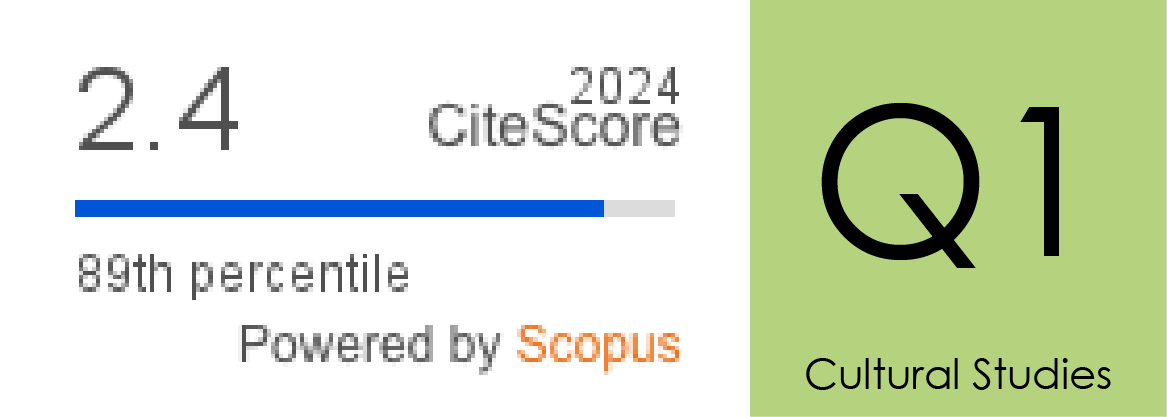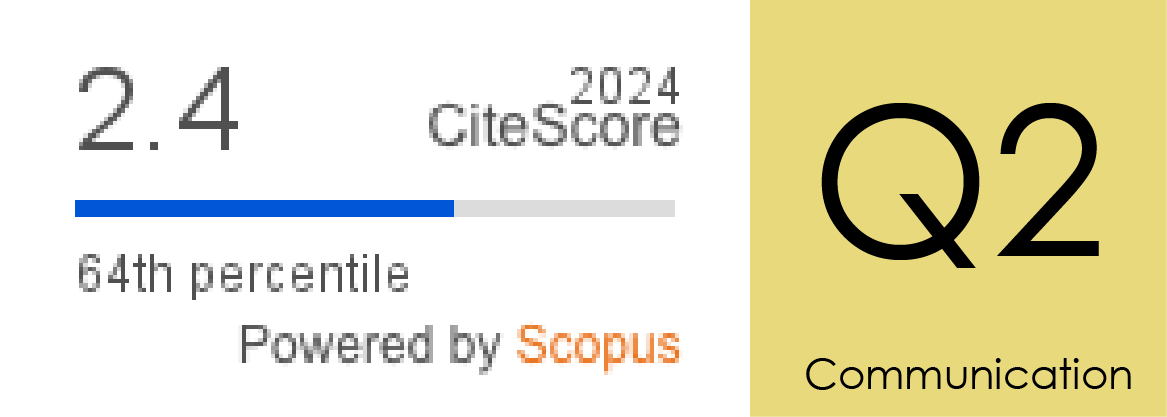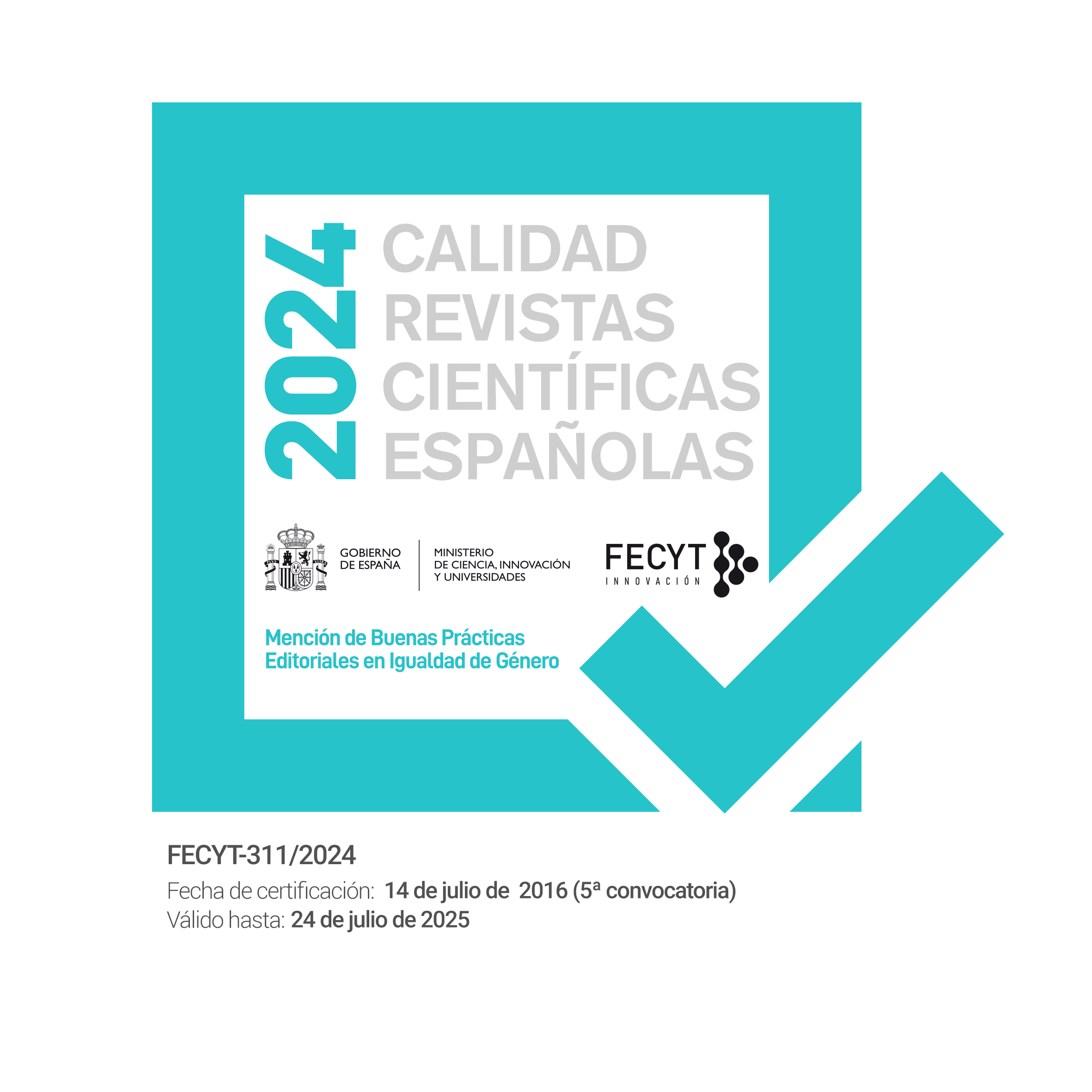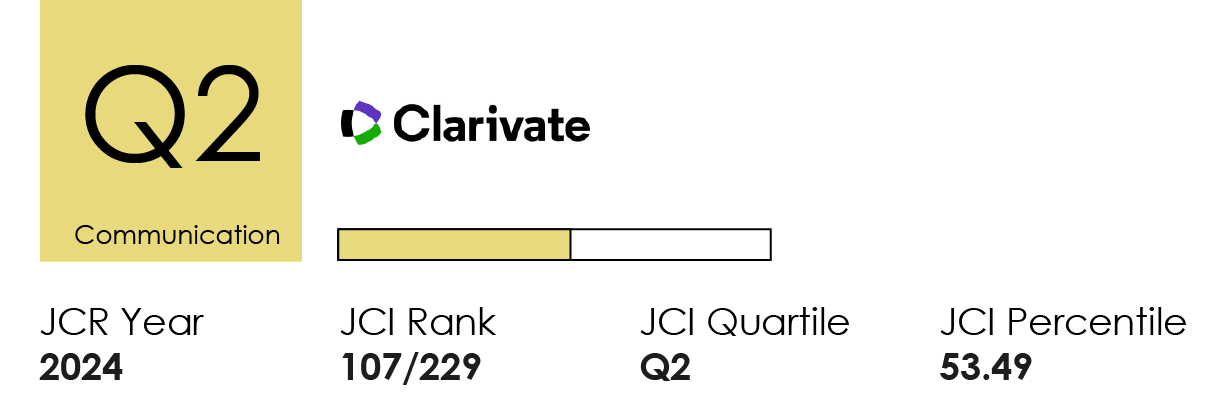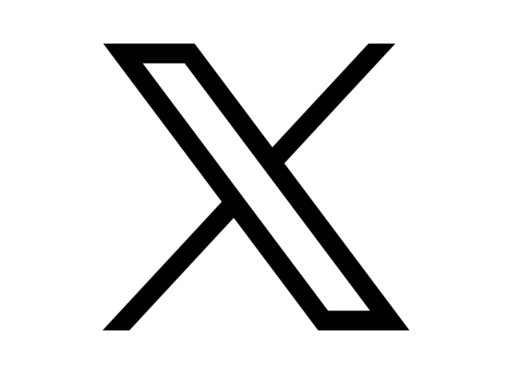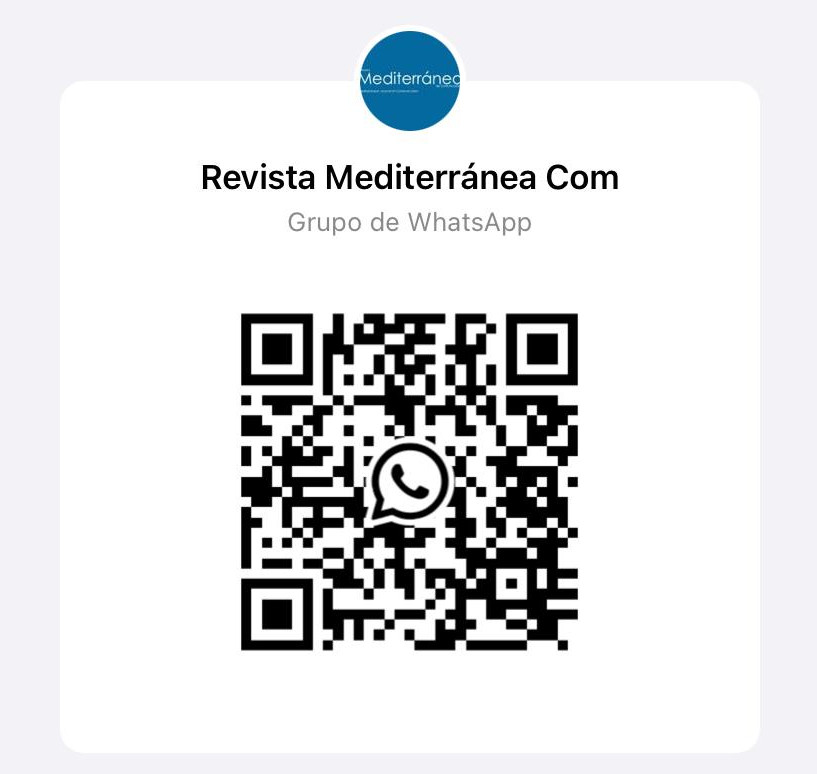Twitter como objeto de investigación en comunicación de la ciencia
DOI:
https://doi.org/10.14198/MEDCOM000006Palabras clave:
Twitter, comunicación de la ciencia, periodismo científico, divulgación, redes sociales, análisis de redesResumen
El servicio de microblogging Twitter, utilizado a la vez como red de información y como red social, es un objeto de investigación emergente con gran potencial para explorar la difusión de la ciencia, pero sobre el que existe cierto desorden teórico. Es por ello que en este artículo se documentan, en primer lugar, una serie de resultados relevantes en estudios de comunicación que se centran en el ecosistema Twitter. En segundo lugar, se sitúa el foco en el ámbito de la comunicación de la ciencia, para el que se exponen trabajos ilustrativos con el fin proporcionar una perspectiva de conjunto sobre los distintos propósitos, enfoques y metodologías utilizadas, en vistas a servir de marco conceptual para trabajos futuros. Además, como resultado de esta compilación, se esclarecen las principales funciones que desempeña Twitter como herramienta de comunicación científica, que dependiendo de los actores involucrados y sus objetivos aparentes se configuran de manera específica e incluso empíricamente observable. Se plantea asimismo una distinción entre dos aproximaciones de investigación; una centrada en la información —los temas científicos de interés público— y otra en los agentes difusores —científicos, periodistas e instituciones—. Por último, se sugieren algunas direcciones de investigación específicas para ulteriores estudios.
Financiación
CSICCitas
Aiello, L. M.; Petkos, G.; Martin, C.; Corney, D.; Papadopoulos, S.; Skraba, R.; Göker, A.; Kompatsiaris, I. & Jaimes, A. (2013). Sensing Trending Topics in Twitter. IEEE Transactions on Multimedia, 15(6), 1268-1282. http://doi.org/f5bzrz
Alperin, J. P.; Gomez, C. J. & Haustein, S. (2019). Identifying diffusion patterns of research articles on Twitter: A case study of online engagement with open access articles. Public Understanding of Science, 28(1), 2-18. http://doi.org/gdg6vs
Álvarez-Bornstein, B. & Montesi, M. (2019). Who is interacting with researchers on Twitter? A survey in the field of Information Science, 10(2), 87-106. http://doi.org/dw88
Becker, B. F. H.; Larson, H. J.; Bonhoeffer, J.; van Mulligen, E. M.; Kors, J. A. & Sturkenboom, M. C. J. M. (2016). Evaluation of a multinational, multilingual vaccine debate on Twitter. Vaccine, 34(50), 6166-6171. http://doi.org/f9h2zn
Berger, J. & Milkman, K. L. (2012). What makes online content viral? Journal of marketing research, 49(2), 192-205. http://doi.org/fxqzn7
Bhattacharya, S.; Srinivasan, P. & Polgreen, P. (2014). Engagement with Health Agencies on Twitter. PLoS One, 9(11), e112235. http://doi.org/dw89
Boyd, D. (16/08/2009). Twitter: ‘Pointless Babble’ or Peripheral Awareness+ Social Grooming. Aphogenia. https://bit.ly/2wXAEx9
Boyd, D.; Golder, S. & Lotan, G. (2010). Tweet, Tweet, Retweet: Conversational Aspects of Retweeting on Twitter. In 2010 43rd Hawaii International Conference on System Sciences. Honolulu, HI. http://doi.org/cn6wj3
Bradley, M. M. & Lang, P. J. (1999). Affective norms for English words (ANEW): Instruction manual and affective ratings. Technical Report C-1. The Center for Research in Psychophysiology, University of Florida.
Brossard, D. & Scheufele, D. A. (2013). Science, New Media, and the Public. Science, 339(6115), 40-41. http://doi.org/j45
Brown, P. (2014). An explosion of alternatives. EMBO reports, 15(8), 827-832. http://doi.org/f2swhw
Castillo, C.; Mendoza, M. & Poblete, B. (2011). Information credibility on twitter. In WWW '11: Proceedings of the 20th international conference on World wide web (pp. 675–684). http://doi.org/bm4s9p
Cha, M.; Haddadi, H.; Benevenuto, F. & Gummadi, K. P. (2010). Measuring user influence in twitter: The million follower fallacy. In Fourth International AAAI Conference on Weblogs and Social Media (pp. 10-17). https://bit.ly/370Y2aO
Chew, C. & Eysenbach, G. (2010). Pandemics in the Age of Twitter: Content Analysis of Tweets during the 2009 H1N1 Outbreak. PLoS One, 5(11), e14118. http://doi.org/cz2jpx
Congosto, M. L. (2016). Caracterización de usuarios y propagación de mensajes en Twitter en el entorno de temas sociales. Universidad Carlos III de Madrid: España. https://bit.ly/3eJz4za
Côté, I. M. & Darling, E. S. (2018). Scientists on Twitter: Preaching to the choir or singing from the rooftops? FACETS, 3(1), 682-694. http://doi.org/gdq9zt
Dann, S. (2010). Twitter content classification. First Monday, 15(12). http://doi.org/dw9b
Darling, E. S.; Shiffman, D.; Côté, I. M. & Drew, J. A. (2013). The role of Twitter in the life cycle of a scientific publication. Ideas in Ecology and Evolution, 6(1). http://doi.org/dw9c
De Choudhury, M.; Lin, Y.-R.; Sundaram, H.; Candan, K. S.; Xie, L. & Kelliher, A. (2010). How does the data sampling strategy impact the discovery of information diffusion in social media? In Fourth International AAAI Conference on Weblogs and Social Media (pp. 34-41). https://bit.ly/2XwEqIs
Dehkharghani, R.; Mercan, H.; Javeed, A. & Saygin, Y. (2014). Sentimental causal rule discovery from Twitter. Expert Systems with Applications, 41(10), 4950-4958. http://doi.org/gghqf5
Díaz-Faes, A. A.; Bowman, T. D. & Costas, R. (2019). Towards a second generation of ‘social media metrics’: Characterizing Twitter communities of attention around science. PLoS One, 14(5), e0216408. http://doi.org/ggdftp
Dodds, P. S.; Harris, K. D.; Kloumann, I. M.; Bliss, C. A. & Danforth, C. M. (2011). Temporal Patterns of Happiness and Information in a Global Social Network: Hedonometrics and Twitter. PLoS One, 6(12), e26752. http://doi.org/b4x9cx
Gerhards, J. & Schäfer, M. S. (2010). Is the internet a better public sphere? Comparing old and new media in the USA and Germany. New Media & Society, 12(1), 143-160. http://doi.org/bjzmbm
Grabowicz, P. A.; Ramasco, J. J.; Moro, E.; Pujol, J. M. & Eguiluz, V. M. (2012). Social Features of Online Networks: The Strength of Intermediary Ties in Online Social Media. PLoS One, 7(1), e29358. http://doi.org/fzs6dq
Hall, N. (2014). The Kardashian index: a measure of discrepant social media profile for scientists. Genome Biology, 15(7), 424. http://doi.org/tw9
Harvey, K. (2014). Klout Score. In K. Harvey (Ed.), Encyclopedia of Social Media and Politics (pp. 753-754). Thousand Oaks, California: SAGE Publications, Inc.
Haunschild, R.; Leydesdorff, L.; Bornmann, L.; Hellsten, I. & Marx, W. (2019). Does the public discuss other topics on climate change than researchers? A comparison of explorative networks based on author keywords and hashtags. Journal of Informetrics, 13(2), 695-707. http://doi.org/dw9d
Haustein, S. (2019). Scholarly Twitter Metrics. In W. Glänzel; H. F. Moed; U. Schmoch & M. Thelwall (Eds.), Springer Handbook of Science and Technology Indicators (pp. 729-760). Cham: Springer International Publishing. http://doi.org/dxkh
Haustein, S.; Bowman, T. D. & Costas, R. (2016). Interpreting ‘Altmetrics’: Viewing Acts on Social Media through the Lens of Citation and Social Theories. In C. Sugimoto (Ed.), Theories of Informetrics and Scholarly Communication (pp. 372-406). Berlin, Boston: De Gruyter. http://doi.org/dxkj
Haustein, S.; Costas, R. & Larivière, V. (2015). Correction: Characterizing Social Media Metrics of Scholarly Papers: The Effect of Document Properties and Collaboration Patterns. PLoS One, 10(5), e0127830. http://doi.org/dw9f
Hellsten, I. & Leydesdorff, L. (2019). Automated analysis of actor–topic networks on twitter: New approaches to the analysis of socio-semantic networks. Journal of the Association for Information Science and Technology, 71(1), 3-15. http://doi.org/ggk2td
Höijer, B. (2010). Emotional anchoring and objectification in the media reporting on climate change. Public Understanding of Science, 19(6), 717-731. http://doi.org/b7r4gv
Holton, A. E.; Baek, K.; Coddington, M. & Yaschur, C. (2014). Seeking and Sharing: Motivations for Linking on Twitter. Communication Research Reports, 31(1), 33-40. http://doi.org/gfgxdk
Huberman, B. A.; Romero, D. M. & Wu, F. (2008). Social networks that matter: Twitter under the microscope. First Monday, 14(1). http://doi.org/dw9g
Hughes, A. L. & Palen, L. (2009). Twitter adoption and use in mass convergence and emergency events. International journal of emergency management, 6(3/4), 248-260. http://doi.org/dh7cpf
Jahng, M. R. & Lee, N. (2018). When Scientists Tweet for Social Changes: Dialogic Communication and Collective Mobilization Strategies by Flint Water Study Scientists on Twitter. Science Communication, 40(1), 89-108. http://doi.org/dw9h
Java, A.; Song, X.; Finin, T. & Tseng, B. (2007). Why we twitter: understanding microblogging usage and communities. In WebKDD/SNA-KDD '07: Proceedings of the 9th WebKDD and 1st SNA-KDD 2007 workshop on Web mining and social network analysis (pp. 56–65). http://doi.org/d3zh2r
Kahle, K.; Sharon, A. J. & Baram-Tsabari, A. (2016). Footprints of Fascination: Digital Traces of Public Engagement with Particle Physics on CERN's Social Media Platforms. PLoS One, 11(5), e0156409. http://doi.org/gbnq6h
Ke, Q.; Ahn, Y.-Y. & Sugimoto, C. R. (2017). A systematic identification and analysis of scientists on Twitter. PLoS One, 12(4), e0175368. http://doi.org/f9z4j6
Kolari, P.; Finin, T.; Yesha, Y.; Yesha, Y.; Lyons, K.; Perelgut, S. & Hawkins, J. (2007). On the structure, properties and utility of internal corporate blogs. In Proceedings of the International Conference on Weblogs and Social Media (ICWSM 2007). https://bit.ly/2Y3z1I5
König, L. & Jucks, R. (2019). Hot topics in science communication: Aggressive language decreases trustworthiness and credibility in scientific debates. Public Understanding of Science, 28(4), 401-416. http://doi.org/dw9j
Kwak, H.; Lee, C.; Park, H. & Moon, S. (2010). What is Twitter, a social network or a news media? In WWW '10: Proceedings of the 19th international conference on World wide web (pp. 591–600). http://doi.org/c2k8cj
Li, N.; Akin, H.; Su, L. Y.-F.; Brossard, D.; Xenos, M. & Scheufele, D. A. (2016). Tweeting disaster: An analysis of online discourse about nuclear power in the wake of the Fukushima Daiichi nuclear accident. Journal of Science Communication, 15(5). http://doi.org/dw9k
Liang, X.: Su, L. Y.-F.; Yeo, S. K.; Scheufele, D. A.; Brossard, D.; Xenos, M.; Nealey, P. & Corley, E. A. (2014). Building Buzz: (Scientists) Communicating Science in New Media Environments. Journalism & Mass Communication Quarterly, 91(4), 772-791. http://doi.org/ggcd8d
Lin, Y.-R.; Keegan, B.; Margolin, D. & Lazer, D. (2014). Rising Tides or Rising Stars?: Dynamics of Shared Attention on Twitter during Media Events. PLoS One, 9(5), e94093. http://doi.org/f56mgp
López Pérez, L. y Olvera Lobo, M. D. (2019). Participación digital del público en la ciencia de excelencia española: análisis de los proyectos financiados por el European Research Council. El profesional de la información, 28(1). http://doi.org/dw9m
Mandavilli, A. (2011). Peer review: Trial by Twitter. Nature, 469(7330), 286-287. http://doi.org/ap2
Murphy, J.; Hill, C. A. & Dean, E. (2013). Social Media, Sociality, and Survey Research. In E. D. C.A. Hill & J. Murphy (Ed.), Social Media, Sociality, and Survey Research (pp. 1-33). John Wiley & Sons. http://doi.org/dxkk
Murthy, D. (2012). Towards a Sociological Understanding of Social Media: Theorizing Twitter. Sociology, 46(6), 1059-1073. http://doi.org/gfc8v9
Myers, S. A.; Sharma, A.; Gupta, P. & Lin, J. (2014). Information network or social network? the structure of the twitter follow graph. In WWW '14 Companion: Proceedings of the 23rd International Conference on World Wide Web (pp. 493–498). http://doi.org/dw9n
Naaman, M.; Boase, J. & Lai, C.-H. (2010). Is it really about me? Message content in social awareness streams. In CSCW '10: Proceedings of the 2010 ACM conference on Computer supported cooperative work (pp. 189–192). http://doi.org/bqxczp
Narr, S.; Luca, E. W. D. & Albayrak, S. (2011). Extracting semantic annotations from twitter. In ESAIR '11: Proceedings of the fourth workshop on Exploiting semantic annotations in information retrieval (pp. 15–16). http://doi.org/dck8ff
Nisbet, M. C. & Scheufele, D. A. (2009). What's next for science communication? Promising directions and lingering distractions. American Journal of Botany, 96(10), 1767-1778. http://doi.org/dv4zw8
PearAnalytics (2009). Twitter study. https://bit.ly/2Y3I4Zi
Pearce, W.; Holmberg, K.; Hellsten, I. & Nerlich, B. (2014). Climate Change on Twitter: Topics, Communities and Conversations about the 2013 IPCC Working Group 1 Report. PLoS One, 9(4), e94785. http://doi.org/f5472q
Percastre-Mendizábal, S.; Pont-Sorribes, C. & Codina, L. (2017). A sample design proposal for the analysis of Twitter in political communication. El profesional de la información (EPI), 26(4), 579-588. http://doi.org/dw9p
Pérez-Rodríguez, A. V.; González-Pedraz, C. & Alonso-Berrocal, J. L. (2018). Twitter como herramienta de comunicación científica en España. Principales agentes y redes de comunicación. Communication Papers, 7(13), 95-112. http://doi.org/dw9q
Peters, H. P.; Dunwoody, S.; Allgaier, J.; Lo, Y.-Y. & Brossard, D. (2014). Public communication of science 2.0. EMBO reports, 15(7), 749-753. http://doi.org/s8s
Pont Sorribes, C.; Cortiñas Rovira, S. & Di Bonito, I. (2013). Challenges and opportunities for science journalists in adopting new technologies: the case of Spain. Journal of Science Communication, 12(3). http://doi.org/dw9r
Priem, J.; Groth, P. & Taraborelli, D. (2012). The Altmetrics Collection. PLoS One, 7(11), e48753. http://doi.org/gf35cr
Quercia, D.; Ellis, J.; Capra, L. & Crowcroft, J. (2011). In the Mood for Being Influential on Twitter. IEEE Third International Conference on Privacy, Security, Risk and Trust and 2011 IEEE Third International Conference on Social Computing (pp. 307-314). Boston, MA. http://doi.org/fzzqh7
Quiñónez Gómez, H. A. y Sánchez Colmenares, M. F. (2017). Uso de twitter en el Periodismo científico. Caso: El Nacional y El Universal en Venezuela (septiembre-octubre de 2014). Estudios sobre el Mensaje Periodístico, 23(1), 553-568. http://doi.org/dw9s
Ribas, C. (2012). La divulgación y la comunicación de la ciencia, en la encrucijada. Sociedad Española de Bioquímica y Biología Molecular, 173, 10-12. https://bit.ly/2Ms9GSL
Robinson-Garcia, N.; Costas, R.; Isett, K.; Melkers, J. & Hicks, D. (2017). The unbearable emptiness of tweeting—About journal articles. PLoS One, 12(8), e0183551. http://doi.org/gbtf8g
Rosselli, R.; Martini, M. & Bragazzi, N. L. (2016). The old and the new: vaccine hesitancy in the era of the Web 2.0. Challenges and opportunities. Journal of preventive medicine and hygiene, 57(1), E47-E50. https://bit.ly/2w7Y02V
Rowlands, I.; Nicholas, D.; Russell, B.; Canty, N. & Watkinson, A. (2011). Social media use in the research workflow. Learned Publishing, 24(3), 183-195. http://doi.org/c8r2bb
Runge, K. K.; Yeo, S. K.; Cacciatore, M.; Scheufele, D. A.; Brossard, D.; Xenos, M.; Anderson, A.; Choi, D.; Kim, J.; Li, N.; Liang, X.; Stubbings, M. & Su, L. Y.-F. (2013). Tweeting nano: how public discourses about nanotechnology develop in social media environments. Journal of Nanoparticle Research, 15(1). http://doi.org/ggxg3k
Sasahara, K.; Hirata, Y.; Toyoda, M.; Kitsuregawa, M.; & Aihara, K. (2013). Quantifying Collective Attention from Tweet Stream. PLoS One, 8(4), e61823. http://doi.org/f43228
Schäfer, M. S. (2012). Online communication on climate change and climate politics: a literature review. WIREs Climate Change, 3(6), 527-543. http://doi.org/f4fmqd
Schmidt, J.-H. (2014). Twitter and the rise of personal publics. In K. Weller; A. Bruns; J. Burgess; M. Mahrt & C. Puschmann (Eds.), Twitter and society (pp. 3-14). New York, USA.
Shema, H.; Bar-Ilan, J. & Thelwall, M. (2012). Research Blogs and the Discussion of Scholarly Information. PLoS One, 7(5), e35869. http://doi.org/hwq
Small, T. A. (2011). What the hashtag? Information, Communication & Society, 14(6), 872-895. http://doi.org/d9hxv3
Sugimoto, C. R.; Work, S.; Larivière, V. & Haustein, S. (2017). Scholarly use of social media and altmetrics: A review of the literature. Journal of the Association for Information Science and Technology, 68(9), 2037-2062. http://doi.org/gbtnkr
Thelwall, M.; Haustein, S.; Larivière, V. & Sugimoto, C. R. (2013). Do Altmetrics Work? Twitter and Ten Other Social Web Services. PLoS One, 8(5), e64841. http://doi.org/q6g
Torres-Salinas, D.; Cabezas-Clavijo, Á. y Jiménez-Contreras, E. (2013). Altmetrics: nuevos indicadores para la comunicación científica en la Web 2.0. Comunicar, 21(41), 53-60. http://doi.org/gdxxhg
Uddin, M.; Imran, M. & Sajjad, H. (2014). Understanding Types of Users on Twitter. In SocialCom-Stanford, California, USA. https://bit.ly/2Y24H0e
Uren, V. & Dadzie, A.-S. (2015). Public science communication on Twitter: a visual analytic approach. Aslib Journal of Information Management, 67(3), 337-355. http://doi.org/dw9t
Van Dijck, J. (2011). Tracing Twitter: The rise of a microblogging platform. International Journal of Media & Cultural Politics, 7(3), 333-348. http://doi.org/fxqd7v
Van Liere, D. (2010). How far does a tweet travel? Information brokers in the twitterverse. In MSM '10: Proceedings of the International Workshop on Modeling Social Media (pp. 1–4). http://doi.org/b3bfc3
Van Noorden, R. (2014). Online collaboration: Scientists and the social network. Nature news, 512(7513), 126-129. http://doi.org/t6v
Veltri, G. (2013). Microblogging and nanotweets: Nanotechnology on Twitter. Public Understanding of Science, 22(7), 832-849. http://doi.org/dw9v
Veltri, G. & Atanasova, D. (2015). Climate change on Twitter: Content, media ecology and information sharing behaviour. Public Understanding of Science, 26(6), 721-737. http://doi.org/gf6dqd
Walter, S.; Lörcher, I. & Brüggemann, M. (2019). Scientific networks on Twitter: Analyzing scientists’ interactions in the climate change debate. Public Understanding of Science, 28(6), 696-712. http://doi.org/gf4c58
Wasike, B. (2019). Citations Gone #Social: Examining the Effect of Altmetrics on Citations and Readership in Communication Research. Social Science Computer Review. http://doi.org/ggdj6k
Waters, R. D. & Jamal, J. Y. (2011). Tweet, tweet, tweet: A content analysis of nonprofit organizations’ Twitter updates. Public Relations Review, 37(3), 321-324. http://doi.org/fm4ctn
Weller, K.; Bruns, A.; Burgess, J.; Mahrt, M. & Puschmann, C. (2013). Twitter and Society. Peter Lang. http://doi.org/dxkm
Westerman, D.; Spence, P. R. & Van Der Heide, B. (2012). A social network as information: The effect of system generated reports of connectedness on credibility on Twitter. Computers in Human Behavior, 28(1), 199-206. http://doi.org/bnxtb6
Wilkinson, D. & Thelwall, M. (2012). Trending Twitter topics in English: An international comparison. Journal of the American Society for Information Science and Technology, 63(8), 1631-1646. http://doi.org/f368bw
Zhao, W. X.; Jiang, J.; Weng, J.; He, J.; Lim, E.-P.; Yan, H. & Li, X. (2011). Comparing Twitter and Traditional Media Using Topic Models. In P. Clough; C. Foley; C. Gurrin; G. J. F. Jones; W. Kraaij; H. Lee & V. Mudoch (Eds.), Advances in Information Retrieval. ECIR 2011. Lecture Notes in Computer Science (pp. 338-349). Berlin, Heidelberg: Springer. http://doi.org/dfzb46
Descargas
Estadísticas
Publicado
Cómo citar
Número
Sección
Licencia
Derechos de autor 2021 Elena Denia

Esta obra está bajo una licencia internacional Creative Commons Atribución-CompartirIgual 4.0.
Los autores y autoras que publican en esta revista están de acuerdo con los siguientes términos:
1 Derechos de autor. Los autores y autoras conservan sus derechos de autor, aunque ceden a la revista de forma no exclusiva los derechos de explotación (reproducción, distribución, comunicación pública y transformación) y garantizan a esta el derecho de primera publicación de su trabajo, el cual estará simultáneamente sujeto a la licencia indicada en punto 2. Los autores pueden establecer otros acuerdos adicionales para la distribución no exclusiva de la versión de la obra publicada en la revista, siempre que exista un reconocimiento de su publicación inicial en esta revista.
© Los autores.
2 Licencia. Los trabajos se publican en la revista sujetos a la licencia de Reconocimiento 4.0 Internacional de Creative Commons (CC BY 4.0); los términos se pueden consultar en https://creativecommons.org/licenses/by/4.0/
Esta licencia permite a terceros compartir (copiar y redistribuir el material en cualquier medio o formato) y adaptar (remezclar, transformar y crear a partir del material para cualquier finalidad, incluso comercial), siempre que se reconozca la autoría y la primera publicación en esta revista (Revista Mediterránea de Comunicación (RMC) / Mediterranean Journal of Communication (MJC), Universidad de Alicante, DOI de la obra), se proporcione un enlace a la licencia y se indique si se han realizado cambios en la obra.
3 Política de autoarchivo. Se recomienda a los autores que difundan sus trabajos a través de Internet para favorecer una circulación y difusión más rápidas y, con ello, un posible aumento en la citación y alcance entre la comunidad científica y académica, en las siguientes condiciones:
No se permite a los autores depositar en un repositorio institucional o temático, página web propia, etc., las versiones preprint (versión antes de ser evaluada) o postprint (versión evaluada y aceptada para su publicación) de sus trabajos antes de su publicación, pero sí el artículo final publicado (versión del editor).


